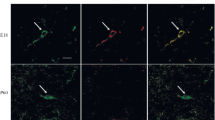Abstract
Dopamine (DA) axons in the developing striatum cluster in discrete areas called “DA islands”. During the third postnatal week, most DA islands are no-longer detectable and the DA innervation becomes uniform. In this study we explored the relationship between the pattern of DA innervation and the number of striatal tyrosine hydroxylase positive (TH+) cells during early postnatal development. By using dedicated stereology we found that the newborn striatum contains striatal TH+ cells, which cluster around newly sprouted DA axons. The number of these cells decreases when DA axons develop a full pattern of striatal innervation. This condition suggests a causal relationship between the amount of striatal DA innervation and the presence of striatal DA neurons. A better knowledge of the mechanisms regulating the ontogenesis of the nigrostriatal DA system may pave the way to strategies of neurorescue of the DA system.





Similar content being viewed by others
References
Baker H, Kobayashi K, Okano H et al (2003) Cortical and striatal expression of tyrosine hydroxylase mRNA in neonatal and adult mice. Cell Mol Neurobiol 23:507–518
Betarbet R, Turner R, Chockkan V et al (1997) Dopaminergic neurons intrinsic to the primate striatum. J Neurosci 17:6761–6768
Bird ED, Spokes EG, Iversen LL (1980) Dopamine and noradrenaline in post-mortem brain in Huntington’s disease and schizophrenic illness. Acta Psychiatr Scand Suppl 280:63–73
Cossette M, Lecomte F, Parent A (2005a) Morphology and distribution of dopaminergic neurons intrinsic to the human striatum. J Chem Neuroanat 29:1–11
Cossette M, Lévesque D, Parent A (2005b) Neurochemical characterization of dopaminergic neurons in human striatum. Parkinsonism Relat Disord 11:277–286
Darmopil S, Muneton-Gomez VC, de Ceballos ML et al (2008) Tyrosine hydroxylase cells appearing in the mouse striatum after dopamine denervation are likely to be projection neurones regulated by l-Dopa. Eur J Neurosci 27:580–592
Dubach M, Schmidt R, Kunkel D et al (1987) Primate neostriatal neurons containing tyrosine hydroxylase: immunohistochemical evidence. Neurosci Lett 75:205–210
Ehringer H, Hornykiewicz O (1960) Distribution of noradrenaline and dopamine (3-hydroxytyramine) in the human brain and their behavior in diseases of the extrapyramidal system. Klin Wochenschr 38:1236–1239
Fuxe K, Anderson K, Schwarcz R et al (1979) Studies on different types of dopamine nerve terminals in the forebrain and their possible interactions with hormones and with neurons containing GABA, glutamate, and opioid peptides. Adv Neurol 24:199–215
Gundersen HJG, Jensen EB (1987) The efficiency of systematic sampling in stereology and its prediction. J Microsc 147:229–263
Gundersen HJG, Jensen EBV, Kieu K et al (1999) The efficiency of systematic sampling in stereology-reconsidered. J Microsc 193:199–211
Hornykiewicz O, Kish SJ (1987) Biochemical pathophysiology of Parkinson’s disease. Adv Neurol 45:19–34
Huot P, Lévesque M, Parent A (2007) The fate of striatal dopaminergic neurons in Parkinson’s disease and Huntington’s chorea. Brain 130:222–232
Jennrich R, Sampson P, Frane J (1988) BMDP statistical software manual. In: Dixon WJ, Brown MB, Engelman L, Hill MA, Jennrich RI (eds) BMDP statistical software manual. University of California Press, Berkeley, pp 483–519
Jollivet C, Montero-Menei CN, Venier-Julienne MC et al (2004) Striatal tyrosine hydroxylase immunoreactive neurons are induced by dihydroxyphenylalanine and nerve growth factor treatment in 6-hydroxydopamine lesioned rat. Neurosci Lett 362:79–82
King MA, Scotty N, Klein RL et al (2002) Particle detection, number estimation and feature measurement in gene transfer studies: optical fractionator stereology integrated with digital image processing and analysis. Methods 28:293–299
Lopez-Real A, Rodriguez-Pallares J, Guerra MJ et al (2003) Localization and functional significance of striatal neurons immunoreactive to aromatic l-amino acid decarboxylase or tyrosine hydroxylase in rat. Brain Res 969:135–146
Mao L, Lau YS, Petroske E et al (2001) Profound astrogenesis in the striatum of adult mice following nigrostriatal dopaminergic lesion by repeated MPTP administration. Brain Res Dev Brain Res 131:57–65
Marsden CD (1982) The mysterious motor function of the basal ganglia: the Robert Wartenberg Lecture. Neurol 32:514–539
Mazloom M, Smith Y (2006) Synaptic microcircuitry of tyrosine hydroxylase- containing neurons and terminals in the striatum of 1-methyl–4-phenyl-1, 2, 3, 6-tetrahydropyridine—treated monkeys. J Comp Neurol 495:453–469
Meredith GE, Farrell T, Kellaghan P et al (1999) Immunocytochemical characterization of catecholaminergic neurons in the rat striatum following dopamine-depleting lesions. Eur J Neurosci 11:3585–3596
Mura A, Jackson D, Manley MS et al (1995) Aromatic l-amino acid decarboxylase immunoreactive cells in the rat striatum: a possible site for the conversion of exogenous l-Dopa to dopamine. Brain Res 704:51–60
Olson L, Seiger A, Fuxe K (1972) Heterogeneity of striatal and limbic dopamine innervation: highly fluorescent islands in developing and adult rats. Brain Res 44:283–288
Porritt MJ, Batchelor PE, Hughes AJ et al (2000) New dopaminergic neurons in Parkinson’s disease striatum. Lancet 356:44–45
Spokes EG (1979) Dopamine in Huntington’s disease: a study of postmortem brain tissue. Adv Neurol 23:481–493
Spokes EG (1980) Neurochemical alterations in Huntington's chorea: a study of post-mortem brain tissue. Brain 103:179–210
Tandé D, Höglinger G, Debeir T et al (2006) New striatal dopamine neurons in MPTP-treated macaques result from a phenotypic shift and not neurogenesis. Brain 129:1194–1200
Tennyson VM, Barrett RE, Cohen G et al (1972) The developing neostriatum of the rabbit: correlation of fluorescence histochemistry, electron microscopy, endogenous dopamine levels, and (3H)dopamine uptake. Brain Res 46:251–285
West MJ, Slomianka L, Gundersen HJG (1991) Unbiased stereological estimation of the total number of neurons in the subdivisions of rat hippocampus using the optical fractionator. Anat Rec 231:482–497
Author information
Authors and Affiliations
Corresponding author
Rights and permissions
About this article
Cite this article
Busceti, C.L., Biagioni, F., Mastroiacovo, F. et al. High number of striatal dopaminergic neurons during early postnatal development: correlation analysis with dopaminergic fibers. J Neural Transm 115, 1375–1383 (2008). https://doi.org/10.1007/s00702-008-0112-x
Received:
Accepted:
Published:
Issue Date:
DOI: https://doi.org/10.1007/s00702-008-0112-x




